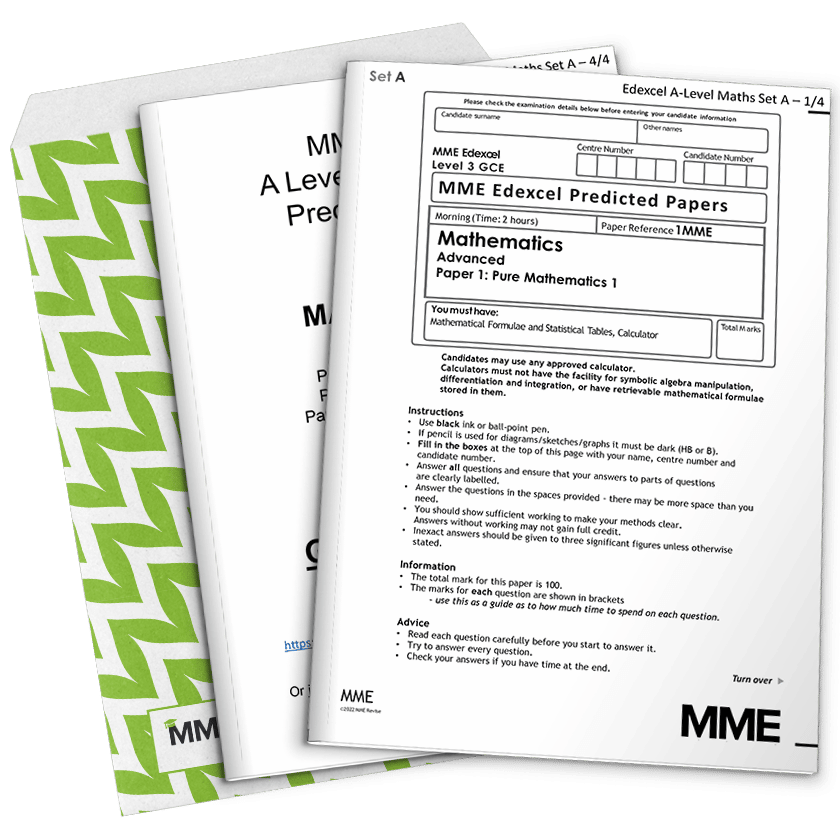Product Rule
Product Rule Revision
Product Rule
We use the product rule to find derivatives of functions which are (funnily enough), products of separate functions – we cannot simply differentiate our terms and multiply them together.
Product Rule Formula
For a function \textcolor{limegreen}{y} = f(\textcolor{blue}{x}) = u(\textcolor{blue}{x})v(\textcolor{blue}{x}), we have the derivative (with respect to \textcolor{blue}{x}) given by
\dfrac{d\textcolor{limegreen}{y}}{d\textcolor{blue}{x}} = \dfrac{df(\textcolor{blue}{x})}{d\textcolor{blue}{x}} = u(\textcolor{blue}{x})\dfrac{dv(\textcolor{blue}{x})}{d\textcolor{blue}{x}} + v(\textcolor{blue}{x})\dfrac{du(\textcolor{blue}{x})}{d\textcolor{blue}{x}}
Extensions to the Formula
Let’s now say that we have \textcolor{limegreen}{y} = u(\textcolor{blue}{x})v(\textcolor{blue}{x})w(\textcolor{blue}{x}), and we want to find derivative with respect to \textcolor{blue}{x}.
By setting u(\textcolor{blue}{x})v(\textcolor{blue}{x}) = a(\textcolor{blue}{x}), we have
\dfrac{d\textcolor{limegreen}{y}}{d\textcolor{blue}{x}} = \dfrac{d(a(\textcolor{blue}{x})w(\textcolor{blue}{x}))}{d\textcolor{blue}{x}}
= a(\textcolor{blue}{x})\dfrac{dw(\textcolor{blue}{x})}{d\textcolor{blue}{x}} + \dfrac{da(\textcolor{blue}{x})}{d\textcolor{blue}{x}}w(\textcolor{blue}{x})
= \dfrac{du(\textcolor{blue}{x})}{d\textcolor{blue}{x}}v(\textcolor{blue}{x})w(\textcolor{blue}{x})+ u(\textcolor{blue}{x})\dfrac{dv(\textcolor{blue}{x})}{d\textcolor{blue}{x}}w(\textcolor{blue}{x}) + u(\textcolor{blue}{x})v(\textcolor{blue}{x})\dfrac{dw(\textcolor{blue}{x})}{d\textcolor{blue}{x}}
This technique can be repeated endlessly for n functions, so we have a linear combination of n terms, where each term is the product of one differentiated function and all other functions.
Example 1: Using the Product Rule
Say we have the function \textcolor{limegreen}{y} = e^{\textcolor{blue}{x}}\sin \textcolor{blue}{x}. Find \dfrac{d\textcolor{limegreen}{y}}{d\textcolor{blue}{x}}.
[2 marks]
Let u(\textcolor{blue}{x}) = e^\textcolor{blue}{x} and v(\textcolor{blue}{x}) = \sin \textcolor{blue}{x}. Then
\dfrac{d\textcolor{limegreen}{y}}{d\textcolor{blue}{x}} = \dfrac{du(\textcolor{blue}{x})}{d\textcolor{blue}{x}}v(\textcolor{blue}{x}) + u(\textcolor{blue}{x})\dfrac{dv(\textcolor{blue}{x})}{d\textcolor{blue}{x}}
= e^\textcolor{blue}{x}\sin \textcolor{blue}{x} + e^\textcolor{blue}{x}\cos \textcolor{blue}{x} = e^\textcolor{blue}{x}(\sin \textcolor{blue}{x} + \cos \textcolor{blue}{x})
Example 2: Using the Product Rule for Larger Functions
Let \textcolor{limegreen}{y} = (\textcolor{blue}{x}^2 - 1)(\ln \textcolor{blue}{x})\cos \textcolor{blue}{x} where \textcolor{blue}{x} is measured in radians. Find \dfrac{d\textcolor{limegreen}{y}}{d\textcolor{blue}{x}} and verify that there is a stationary point at the point (1, 0).
[4 marks]
Let u(\textcolor{blue}{x}) = \textcolor{blue}{x}^2 - 1, v(\textcolor{blue}{x}) = \ln \textcolor{blue}{x} and w(\textcolor{blue}{x}) = \cos \textcolor{blue}{x}. Then
\dfrac{du}{d\textcolor{blue}{x}} = 2\textcolor{blue}{x}, \dfrac{dv}{d\textcolor{blue}{x}} = \dfrac{1}{\textcolor{blue}{x}} and \dfrac{dw}{d\textcolor{blue}{x}} = -\sin \textcolor{blue}{x}
This gives
\dfrac{d\textcolor{limegreen}{y}}{d\textcolor{blue}{x}} = (2\textcolor{blue}{x}\ln \textcolor{blue}{x} \cos \textcolor{blue}{x}) + \left( \dfrac{(\textcolor{blue}{x}^2 - 1)\cos \textcolor{blue}{x}}{\textcolor{blue}{x}}\right) - ((\textcolor{blue}{x}^2 - 1)\ln \textcolor{blue}{x}\sin \textcolor{blue}{x})
When \textcolor{blue}{x} = 1,
\dfrac{d\textcolor{limegreen}{y}}{d\textcolor{blue}{x}} = (2(1)\ln 1 \cos 1) + \left( \dfrac{0\cos 1}{1}\right) - \left( 0\ln 1 \sin 1\right)
= 0
So, we can confirm that there is a stationary point at \textcolor{blue}{x} = 1.
Product Rule Example Questions
Question 1: Using the product rule, show that the function y = x^3 has derivative \dfrac{dy}{dx} = 3x^2.
[2 marks]
Let u(x) = x and v(x) = x^2.
Then
\dfrac{dy}{dx} = 1x^2 + x2x
= x^2 + 2x^2
= 3x^2
Question 2: For f(x) = 2\sin x \cos x, use the product rule to find its derivative with respect to x, and prove that 2\sin x \cos x = \sin 2x.
[4 marks]
Let u(x) = 2\sin x and v(x) = \cos x. Then
\dfrac{df(x)}{dx} = 2\cos x \cos x - 2\sin x \sin x
= 2\cos 2x, by double angle formulae.
We also have
\dfrac{d(\sin 2x)}{dx} = 2\cos 2x
Therefore, \dfrac{d(\sin 2x)}{dx} = \dfrac{d(2\sin x \cos x)}{dx}
This is an example of the Uniqueness Theorem. You won’t necessarily need this, but it’s an interesting proof, all the same.
Question 3: Find the derivative (w.r.t x), of the function y = x^3 3^x\tan x where x is measured in radians. Verify that there is a stationary point at the origin.
[4 marks]
Set u = x^3, v = 3^x and w = \tan x.
Then
u' = 3x^2, v' = 3^x\ln 3 and w' = \sec ^2 x
Using the rule we learned for extended functions, we have
\dfrac{dy}{dx} = (3x^2 3^x \tan x) + (x^3 3^x\ln 3 \tan x) + (x^3 3^x \sec ^2 x)
Set x = 0 to give
\dfrac{dy}{dx} = (0 \times 1 \times \tan 0) + (0 \times \ln 3 \times \tan 0) + (0 \times 1 \times \sec ^2 0)
= 0
So, we can confirm there is a stationary point at the origin.
You May Also Like...

MME Learning Portal
Online exams, practice questions and revision videos for every GCSE level 9-1 topic! No fees, no trial period, just totally free access to the UK’s best GCSE maths revision platform.






